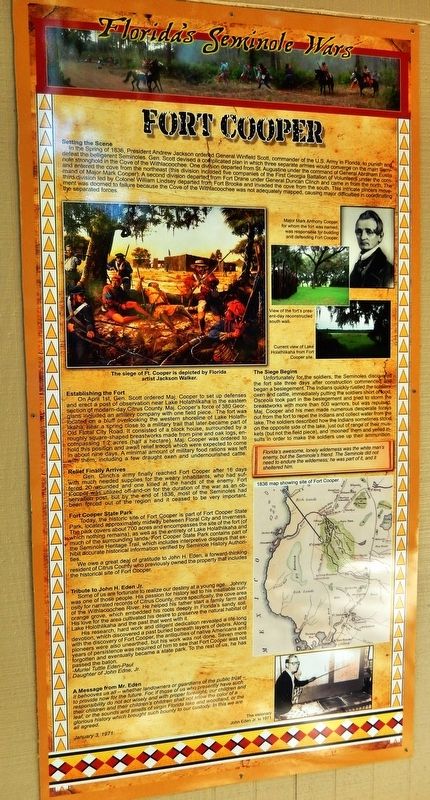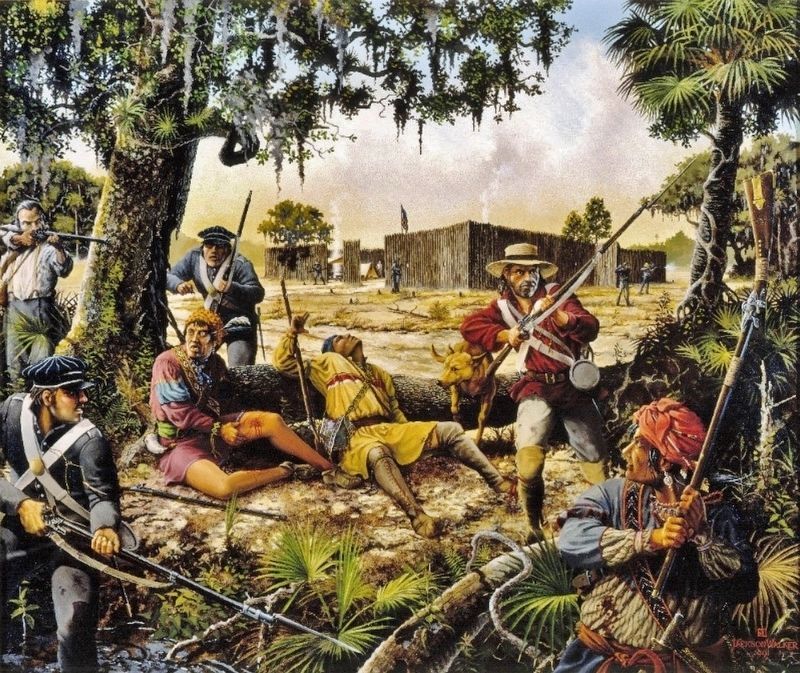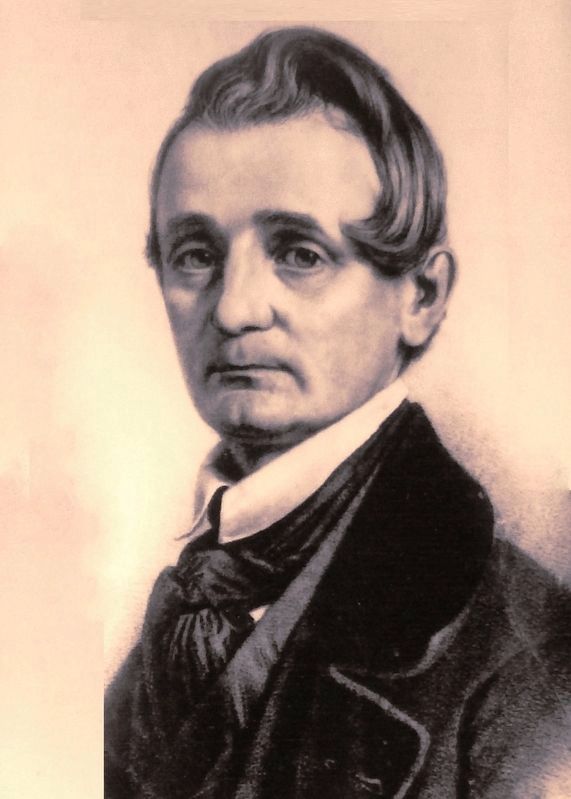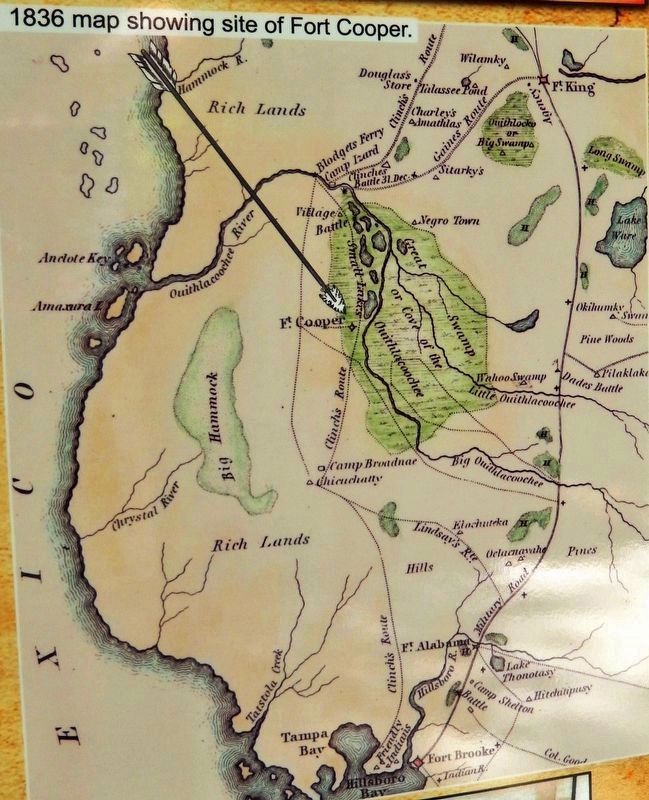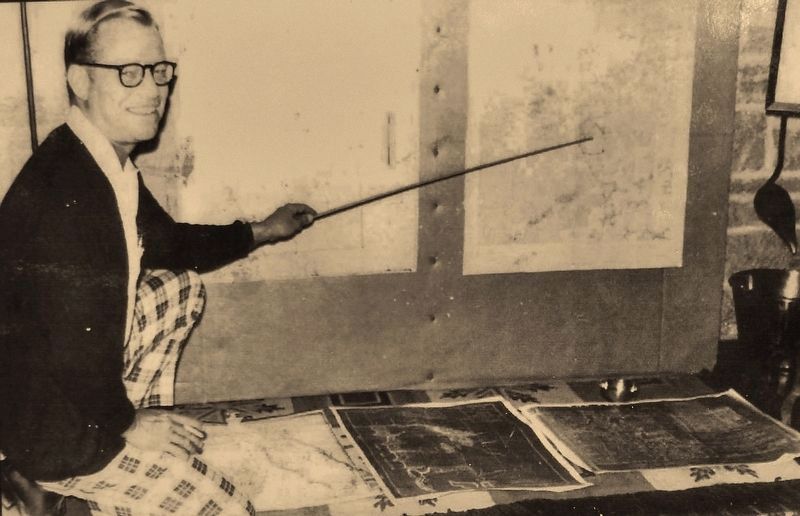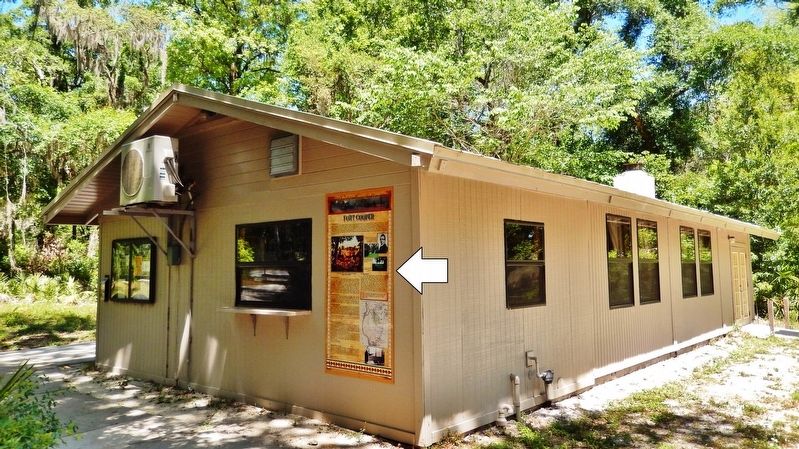Near Inverness in Citrus County, Florida — The American South (South Atlantic)
Fort Cooper
Florida's Seminole Wars
Setting the Scene
In the Spring of 1836, President Andrew Jackson ordered General Winfield Scott, commander of the U.S. Army in Florida, to punish and defeat the belligerent Seminoles. Gen. Scott devised a complicated plan in which three separate armies would converge on the main Seminole stronghold in the Cove of the Withlacoochee. One division departed from St. Augustine under the command of General Abraham Eustis and entered the cove from the northeast (this division included five companies of the First Georgia Battalion of Volunteers under the command of Major Mark Cooper). A second division departed from Fort Drane under General Duncan Clinch and came in from the north. The third division led by Colonel William Lindsey departed from Fort Brooke and invaded the cove from the south. This intricate pincers movement was doomed to failure because the Cove of the Withlacoochee was not adequately mapped, causing major difficulties in coordinating the separated forces.
Establishing the Fort
On April 1st, Gen. Scott ordered Maj. Cooper to set up defenses and erect a post of observation near Lake Holathlikaha in the eastern section of modern-day Citrus County. Maj. Cooper's force of 380 Georgians included an artillery company with one field piece. The fort was located on a bluff overlooking the western shoreline of Lake Holathlikaha, near a spring close to a military trail that later became part of Old Floral City Road. It consisted of a block house, surrounded by a roughly square-shaped breastworks made from pine and oak logs, encompassing 1.2 acres (half a hectare). Maj. Cooper was ordered to hold this position and await relief troops which were expected to come in about nine days. A minimal amount of military food rations was left with them, including a few draught oxen and undernourished cattle.
The Siege Begins
Unfortunately for the soldiers, the Seminoles discovered the fort site three days after construction commenced and began a besiegement. The Indians quickly rustled the soldiers' oxen and cattle, immediately putting the soldiers short of food. Osceola took part in the besiegement and tried to storm the breastworks with more than 500 warriors, but was repulsed. Maj. Cooper and his men made numerous desperate forays out from the fort to repel the Indians and collect water from the lake. The soldiers described how the Indians sometimes stood on the opposite side of the lake, just out of range of their muskets (but not the field piece), and “mooned” them and yelled insults in order to make the soldiers use up their ammunition
Florida's awesome, lonely wilderness was the white man's enemy, but the Seminole's friend. The Seminole did not need to endure the wilderness; he was part of it, and it sheltered him.
Relief Finally Arrives
Gen. Clinch's army finally reached Fort Cooper after 16 days with much needed supplies for the weary inhabitants, who had suffered 20 wounded and one killed at the hands of the enemy. Fort Cooper was utilized off-and-on for the duration of the war as an observation post, but by the end of 1836, most of the Seminoles had been forced out of the region and it ceased to be very important.
Fort Cooper State Park
Today, the historic site of Fort Cooper is part of Fort Cooper State Park, located approximately midway between Floral City and Inverness. The park covers about 700 acres and encompasses the site of the fort (of which nothing remains), as well as the entirety of Lake Holathlikaha and much of the surrounding lands. Fort Cooper State Park contains part of the Seminole Heritage Trail, which includes interpretive displays that exhibit accurate historical information verified by Seminole History Authorities.
We owe a great debt of gratitude to John H. Eden, a forward-thinking resident of Citrus County who previously owned the property that includes the historical site of Fort Cooper.
Tribute to John H. Eden Jr.
Some of us are fortunate to realize our destiny at a young age… Johnny was one of those people. His passion
for history led to his insatiable curiosity for narrated records of Citrus County, more specifically, the cove area of the Withlacoochee River. He helped his father start a family farm and orange grove, which embedded his roots deeply in Florida's sandy soil. His love for the area cultivated his desire to preserve the natural habitat of Lake Holathlikaha and the past that went with it.
His research, hard work and diligent dedication revealed a life-long devotion, which discovered a past buried beneath layers of debris. Along with the discovery of Fort Cooper, the antiquities of native Americans and pioneers were also unearthed, but his work was not done. Seven more years of persistence was required of him to see that Fort Cooper was not forgotten and eventually became a state park. To the rest of us, he has passed the baton.
-Muriel Tuttle Eden-Paul
Daughter of John Eden, Jr.
A Message from Mr. Eden
It behooves us all — whether landowners or guardians of the public trust — to provide now for the future. For, if those of us who presently have such responsibility do not act wisely and with proper foresight, our children and their children and their children's children shall not know the color of a leaf, or the sounds and smells of virgin Florida lake and woodland, or the glorious history which brought such bounty to our custody. In this we are all agreed.
January 3, 1971
(photo captions)
• The siege of Ft. Cooper is depicted by Florida artist Jackson Walker.
• Major Mark Anthony Cooper, for whom the fort was named, was responsible for building and defending Fort Cooper.
• View of the fort’s present-day reconstructed south wall.
• Current view of Lake Holathlikaha from Fort Cooper site.
• 1836 map showing site of Fort Cooper.
• The visionary John Eden, Jr. in 1971.
Topics. This historical marker is listed in these topic lists: Forts and Castles • Native Americans • Settlements & Settlers • Wars, US Indian. A significant historical month for this entry is April 1836.
Location. 28° 48.48′ N, 82° 18.288′ W. Marker is near Inverness, Florida, in Citrus County. Marker can be reached from Old Floral City Road, 0.2 miles south of Carnegie Drive, on the right when traveling south. Marker is located within Fort Cooper State Park, mounted at eye-level near the southwest corner of the park office building, about 3/4 mile inside the park and a short walk from the parking lot. Touch for map. Marker is at or near this postal address: 3100 South Old Floral City Road, Inverness FL 34450, United States of America. Touch for directions.
Other nearby markers. At least 8 other markers are within walking distance of this marker. Florida's First People (about 300 feet away, measured in a direct line); The Seminole in the Cove of the Withlacoochee (about 300 feet away); Life Along the Withlacoochee (about 600 feet away); Old Military Road (approx. 0.3 miles away); War Comes to the Cove (approx. 0.3 miles away); Lonely Outpost in a Hostile Land (approx. 0.3 miles away); A Costly Florida War (approx. 0.4 miles away); a different marker also named Fort Cooper (approx. 0.6 miles away). Touch for a list and map of all markers in Inverness.
Related markers. Click here for a list of markers that are related to this marker. Fort Cooper, The Seminole Heritage Trail, and the Second Seminole War
Also see . . . Fort Cooper. The fort is named for Major Mark Anthony Cooper, commander of 380 First Georgia Battalion Volunteers plus an artillery company of a few army regulars. In April 1836 Major Mark Anthony Cooper built a fort near the lake’s edge to protect the sick and wounded left behind by General Scott as he continued on his way to Fort Brooke. (Submitted on April 15, 2019, by Cosmos Mariner of Cape Canaveral, Florida.)
Credits. This page was last revised on April 18, 2019. It was originally submitted on April 12, 2019, by Cosmos Mariner of Cape Canaveral, Florida. This page has been viewed 308 times since then and 40 times this year. Photos: 1, 2, 3. submitted on April 15, 2019, by Cosmos Mariner of Cape Canaveral, Florida. 4, 5. submitted on April 17, 2019, by Cosmos Mariner of Cape Canaveral, Florida. 6. submitted on April 15, 2019, by Cosmos Mariner of Cape Canaveral, Florida.
